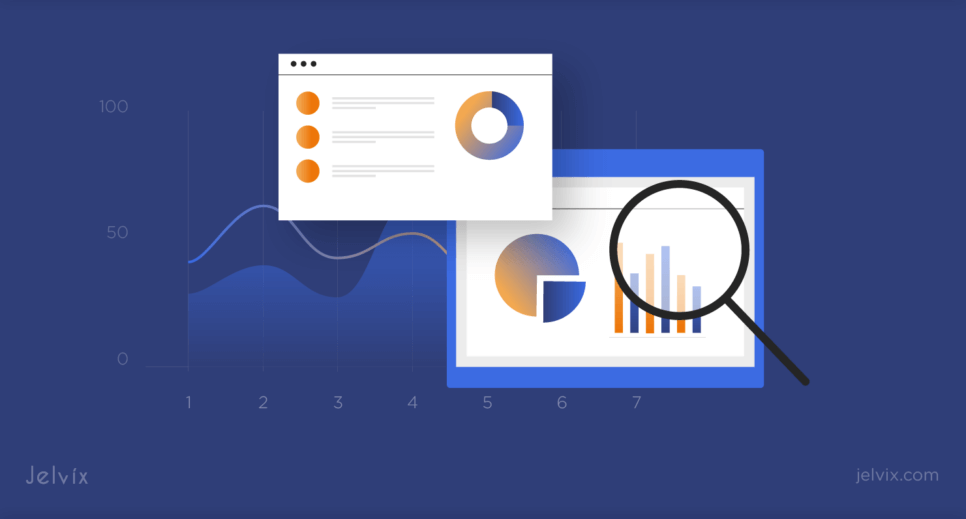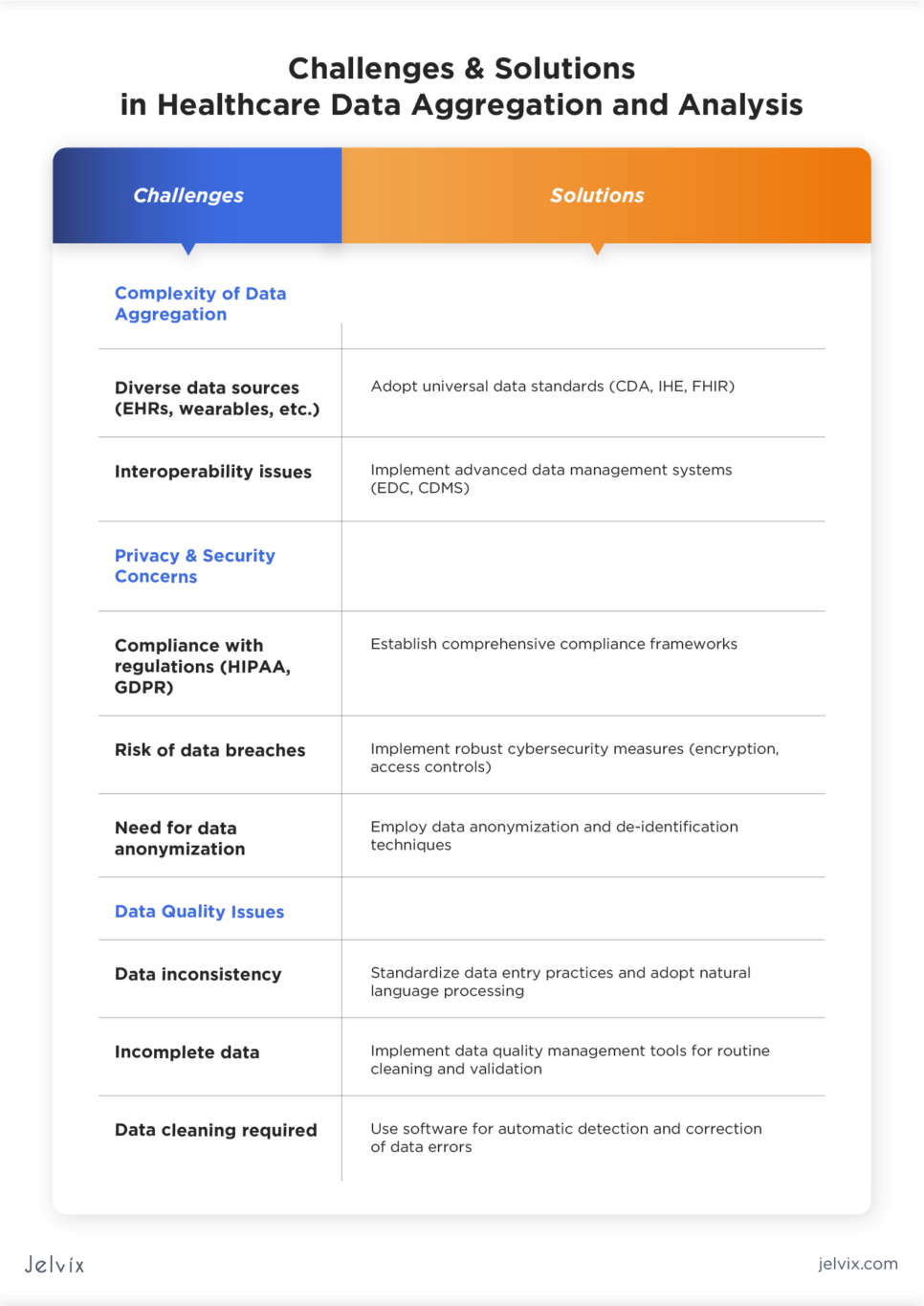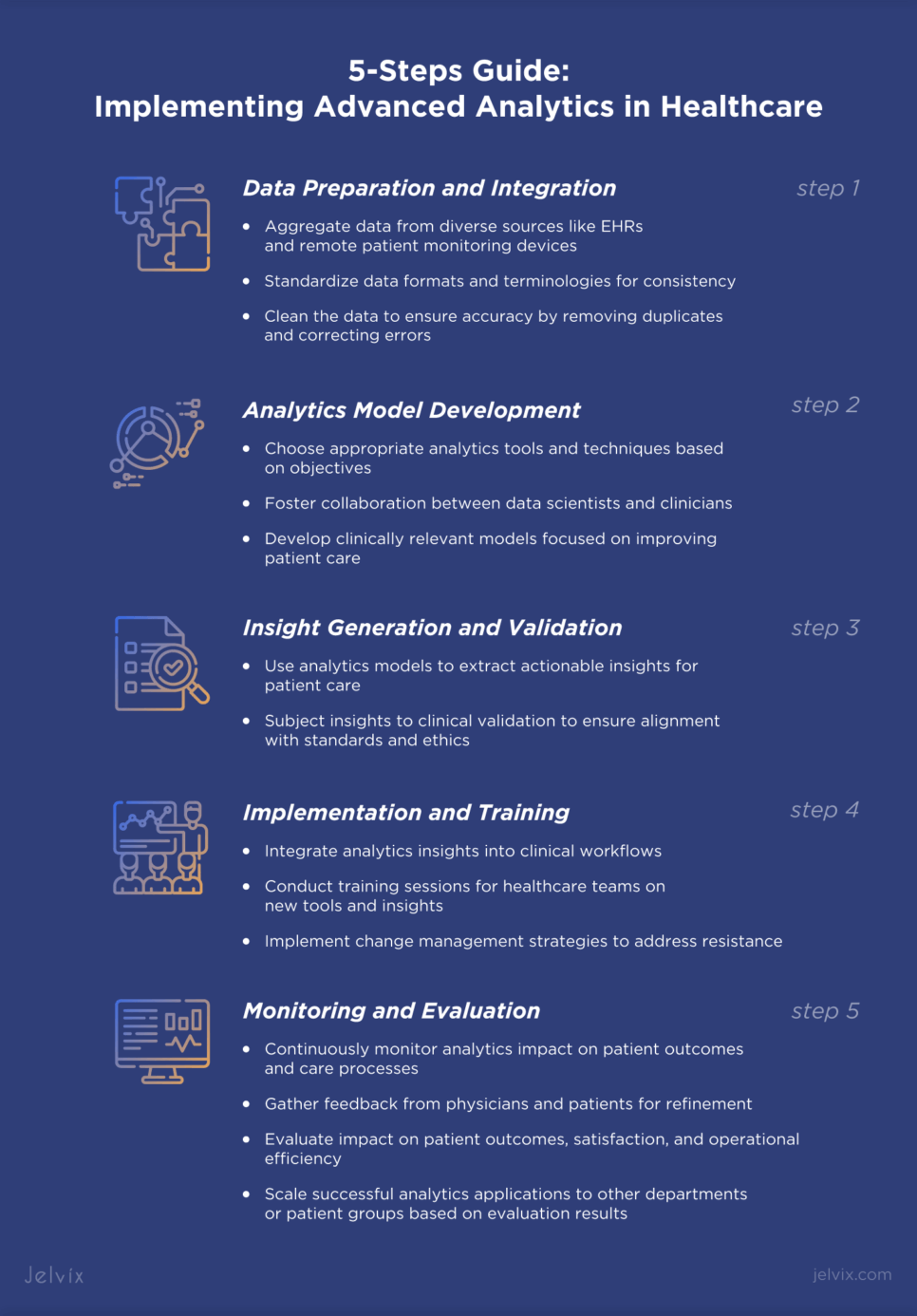As technologies keep developing, we generate more data than we have ever before. About 30% of the world’s information is generated by the healthcare sector, as reported by RBC Capital Markets. This volume is only set to expand, with projections indicating a compound annual growth rate of healthcare data reaching 36% by 2025.
In this context, the importance of healthcare data analytics is seen as a tool for managing this vast amount of data and a critical driver for informed decision-making that can significantly enhance patient care and operational efficiency.
If you want to learn how to handle big amounts of data and use it to drive decision-making in healthcare, this article is for you. Keep reading to find out how to leverage data analytics for better health outcomes.
The Role of Big Data and Analytics in Healthcare
The integration of data analytics into healthcare decision-making allows for more informed, efficient, and patient-centric care. Since the volume of healthcare data is exploding thanks to digital health records and wearable technology, data analytics has become a must-have tool for healthcare providers and vendors.
Why Is Healthcare Big Data Analytics Important?
As reported by Gartner, poor data quality results in an annual cost of $12.9 million to companies worldwide. Big data changes the way how data is used and operated, improving its quality and offering wider opportunities for insights, efficiency, and care personalization.
Organizations that leverage big data gain comprehensive insights for improved decision-making, enabling a holistic view of patient health and healthcare trends. This data-driven approach advances personalized medicine, allowing treatments to be tailored to individual patient needs. This approach results in enhancing treatment effectiveness and reducing adverse reactions.
Big data for healthcare helps boost operational efficiency, with predictive analytics optimizing staffing and resource management and helping identify delivery inefficiencies. For population health management, big data informs public health strategies, monitors disease outbreaks, and guides resource allocation. It accelerates medical research and innovation by uncovering disease patterns and speeding up the development of new treatments, significantly reducing research costs and timelines.
Benefits of Big Data in Healthcare Decision-Making
By embracing data analytics, the healthcare sector can navigate the complexities of modern care delivery, making decisions that benefit patients, physicians, and the broader health ecosystem.
Enhancing Patient Care and Outcomes
Data analytics enables healthcare pros to make informed decisions by leveraging patient data, clinical outcomes, and research findings. This wealth of information helps in diagnosing diseases more accurately, predicting potential health risks, and personalizing treatment plans to suit individual patient needs. For instance, by analyzing patterns within patient data, healthcare professionals can identify risk factors for chronic diseases early, allowing for preventative measures to be implemented timely. Additionally, data analytics facilitates the monitoring of treatment effectiveness, enabling adjustments to be made in real time to optimize patient care.
Operational Efficiency and Resource Allocation
The operational complexities of healthcare systems demand efficient management of resources to ensure high-quality patient care while minimizing costs. Data analytics plays a crucial role in streamlining operations, from optimizing staff scheduling based on patient flow predictions to managing inventory by predicting future supply needs. By identifying inefficiencies and bottlenecks in care delivery, healthcare organizations can implement targeted improvements, reducing wait times and enhancing the patient experience.
Informed Strategic Planning
Strategic planning in healthcare benefits greatly from data analytics through evidence-based decision-making. Analyzing trends in patient demographics, disease prevalence, and healthcare utilization enables healthcare teams to forecast future needs and plan accordingly. This foresight is essential for capacity planning, service expansion, and investment in new technologies or facilities. Furthermore, data analytics supports the evaluation of new healthcare initiatives, allowing organizations to assess their impact and make data-driven adjustments to their strategies.
Personalized Medicine and Population Health Management
The vast amounts of data generated through electronic health records (EHRs) and wearable technology are essential for providing personalized care. Data analytics allows for the integration of this information to tailor healthcare interventions to individual genetic profiles, lifestyles, and environmental exposures. On a larger scale, analyzing population health data enables public health officials to identify health trends, manage disease outbreaks, and implement community health programs more effectively.
Addressing the Complexity and Underutilization of Healthcare Data
The healthcare industry generates a vast amount of data daily, from patient records and treatment outcomes to operational logistics and financial transactions. However, the complexity and underutilization of this data present significant challenges for healthcare organizations aiming to harness its full potential. Addressing these challenges requires an informed effort to implement data governance policies, invest in technology infrastructure, and enhance data literacy across the healthcare workforce.
Breaking Down Data Silos
One of the primary obstacles to effective data utilization in healthcare is the existence of data silos. Patient information often resides in disparate systems within a single healthcare organization, making it difficult to aggregate and analyze data comprehensively. Implementing interoperable healthcare systems that can communicate and share data seamlessly is required. Adopting standards like HL7 and FHIR can facilitate this integration, providing a comprehensive view of patient health and enabling informed decision-making.
Enhancing Data Quality and Management
The quality of data in healthcare can vary significantly, with issues such as incomplete records, inconsistent formatting, and duplication posing barriers to effective analysis. Establishing robust data governance frameworks is essential for ensuring data accuracy, consistency, and reliability. Regular audits, data cleaning processes, and the adoption of standardized data entry protocols can significantly improve data quality, making it more useful for analytics.
Using Advanced Analytics and AI
The complexity of healthcare data, including unstructured data like clinical notes and imaging, often exceeds the capabilities of traditional data analysis tools. Investing in advanced analytics, artificial intelligence (AI), and machine learning (ML) technologies can help healthcare organizations extract meaningful insights from complex datasets. These tools can identify patterns, predict outcomes, and generate actionable insights, supporting better patient care and operational decisions.
Addressing Privacy and Security Concerns
The sensitive nature of healthcare data raises significant privacy and security concerns. The risk of data breaches and the need to comply with regulations like HIPAA add layers of complexity to data management. Implementing robust cybersecurity measures and data privacy protocols is essential. This includes encryption, access controls, regular security audits, and employee training on data handling best practices. Additionally, anonymizing data used for analytics can help protect patient privacy.
Building Data Literacy
The lack of data literacy among healthcare professionals can lead to underutilization of available data insights. Developing comprehensive training programs to enhance data literacy across the organization is crucial. Empowering healthcare providers and administrators to understand and use data analytics in their decision-making processes can maximize the value derived from data.
Fostering a Culture of Innovation
Resistance to change and skepticism about the value of data analytics can hinder its adoption and use. Cultivating a culture that values innovation, continuous improvement, and evidence-based decision-making is key to the adoption of data analytics tools.
Let's take a look at the most common types of clinical trial management software and examine the offers from the best-known clinical trial management system vendors.
Types of Big Data Analytics for Healthcare Entities
By leveraging different types of data analytics, vendors and providers can gain insights into their medical system’s past performance, forecast future trends, and optimize care delivery for better health outcomes. This multifaceted approach involves descriptive, predictive, and prescriptive analytics, each offering unique benefits.
Understand Past Performance with Descriptive Analytics
Descriptive analytics involves the use of historical data to understand changes over time, providing insights into patient populations, treatment outcomes, and operational efficiency:
- Performance analysis: healthcare providers can analyze historical data to assess the effectiveness of treatments, patient satisfaction levels, and the efficiency of healthcare delivery processes;
- Trend identification: by examining data trends, such as the prevalence of certain diseases or utilization rates of healthcare services, organizations can identify areas needing attention or improvement.
Descriptive analytics offers a backward-looking view that helps healthcare organizations understand where they have been and how current trends might impact future operations or patient care strategies.
Forecast Future Health Trends and Outcomes with Predictive Analytics
Predictive analytics goes a step further by using historical data to make predictions about future events. It leverages inferential statistics and ML algorithms to forecast potential outcomes, helping providers and vendors prepare for future challenges:
- Disease risk prediction: by analyzing patient data, including medical histories and lifestyle factors, predictive models can identify individuals at high risk for certain conditions, enabling early intervention;
- Resource allocation: predictive analytics can forecast patient admission rates, helping hospitals optimize staffing and resource allocation to meet anticipated demand.
Predictive analytics empowers healthcare organizations to move from reactive to proactive management, enhancing patient care and operational efficiency through informed forecasting.
Discover how RPM is revolutionizing healthcare delivery and patient care through predictive analytics.
Optimize Treatment Plans and Improve Patient Care with Prescriptive Analytics
Prescriptive analytics represents the cutting edge of data analytics in healthcare. It not only predicts what might happen but also suggests actions to achieve desired outcomes. This type of analytics combines insights from descriptive and predictive analytics with advanced algorithms to recommend specific courses of action:
- Personalized medicine: prescriptive analytics can examine data from various sources, including patient records and wearables, to recommend personalized treatment plans that are likely to be most effective for individual patients;
- Operational optimization: prescriptive analytics can suggest changes to workflows, patient care processes, or resource allocation to improve efficiency and patient outcomes.
By employing prescriptive analytics, healthcare entities can tailor treatments to individual patient needs, optimize operational decisions, and take a significant step towards truly personalized healthcare delivery.
Challenges in Healthcare Data Aggregation and Analysis
The use of data analytics in healthcare promises significant improvements in patient outcomes and operational efficiencies. However, the process of analyzing healthcare data is full of challenges. These hurdles originate from the complexity of healthcare data systems, privacy and security requirements, and issues of data quality. Addressing these challenges is vital for healthcare organizations aiming to leverage the full potential of data analytics.
Understanding the Complexity of Data Aggregation in Healthcare
Healthcare data comes from a multitude of sources, including EHRs, medical imaging, laboratory results, and patient-generated data from wearable devices. Each of these sources may use different formats, standards, and terminologies, making data aggregation a complex task.
Interoperability
The ability of different healthcare systems to communicate, exchange data, and use the information that has been exchanged is a significant challenge. Many healthcare systems operate in silos, with proprietary formats and protocols that hinder seamless data sharing and aggregation. The Jelvix team recommends that vendors and providers adopt universal data standards like CDA, IHE, and FHIR to enhance interoperability among different healthcare systems.
Data Volume
As was noted earlier in this article, the healthcare sector generates almost one-third of the world’s information. It means that the sheer volume of medical data can be overwhelming, complicating the process of aggregation and analysis. Consider implementing advanced data management and storage solutions, such as electronic data capture (EDC) and clinical data management systems (CDMS), to manage the volume of data, making it more accessible for analysis.
Overcoming Data Privacy and Security Concerns in Healthcare Analytics
The sensitive nature of healthcare data requires robust privacy and security measures. Regulations like HIPAA in the U.S. and GDPR in the EU set strict guidelines for handling patient data, posing challenges for data aggregation and analysis.
Regulatory Compliance
Ensuring that data aggregation and analysis practices comply with relevant laws and regulations is a complex and ongoing challenge. Healthcare organizations should establish comprehensive compliance frameworks that encompass all aspects of data privacy and security, ensuring that data handling practices meet or exceed regulatory requirements. Consider using a HIPAA-compliant cloud storage, such as AWS Cloud or Microsoft Azure, to ensure data management and access in a secure and compliant way.
Protection Against Data Breached
The risk of data breaches and cyberattacks is a constant concern, with potentially severe consequences for patient privacy and organizational reputation. Implementing robust cybersecurity measures, including data encryption protocols, role-based access controls, defense-in-depth strategies, and regular security audits, can protect against data breaches.
Data Anonymization and De-Identification
Anonymizing or de-identifying patient data before it’s used in analytics can significantly reduce privacy risks. This process involves removing or modifying personal identifiers to prevent the data from being linked back to individual patients.
Addressing Data Quality Issues: Strategies for Ensuring Accuracy and Reliability
The quality of healthcare data directly impacts the accuracy and reliability of analytics outcomes. Inaccurate, incomplete, or inconsistent data can lead to misleading insights and potentially harmful decisions.
Data Inconsistency
Variations in data entry practices and standards across different sources can result in inconsistent data. Standardizing data entry practices and adopting technologies like natural language processing can help improve data consistency.
Data Completeness
Missing data is a common issue in healthcare records, complicating efforts to gain a comprehensive view of patient health. Implementing data quality management tools and processes, including routine data cleaning and validation checks, can help enhance the completeness and accuracy of healthcare data.
Data Cleaning
Data cleaning involves identifying and correcting errors, inconsistencies, and duplications in data sets. This process is vital for maintaining the accuracy and reliability of healthcare data. Using software that automatically detects and corrects common data errors can help maintain high data quality without requiring extensive manual effort.
Implementing Data Analytics Solutions in Healthcare
The adoption of data analytics in healthcare settings can change the way patients get care. By using the power of data, providers and vendors can make informed decisions, tailor treatments to individual patient needs, and streamline clinical operations. Implementing these solutions, however, requires a structured approach and an understanding of the stages involved in analytics implementation.
Strategies for Implementing Advanced Analytics in Healthcare for Patient-Centric Decision-Making
The Jelvix team recommends following a structured approach to implementing data insights through various stages of analytics implementation.
Stage 1. Data Preparation and Integration
Aggregate data from diverse sources like EHRs and remote patient monitoring devices to ensure a holistic view of patient health. Standardize data formats and terminologies across different sources and clean the data to ensure accuracy, removing duplicates and correcting errors.
Stage 2. Analytics Model Development
Choose the appropriate analytics tools and techniques (descriptive, predictive, or prescriptive) based on your objectives. Consider tools that offer scalability and integration capabilities with existing healthcare systems. Foster a collaborative environment where data scientists work closely with clinicians to develop models that are clinically relevant and focused on improving patient care.
Stage 3. Insight Generation and Validation
Use analytics models to extract actionable insights that can inform patient care, such as risk factors for diseases, potential outcomes of treatment plans, and patient response predictions. Subject the insights generated from data analytics to clinical validation, ensuring they align with clinical expertise, patient care standards, and ethical considerations.
Stage 4. Implementation and Training
Develop strategies to integrate analytics insights into clinical workflows, such as decision support systems, personalized treatment plans, and patient monitoring protocols. Conduct training sessions for healthcare teams to familiarize them with the new tools and insights. Implement change management strategies to address resistance and ensure smooth adoption.
Stage 5. Monitoring and Evaluation
Establish mechanisms for continuous monitoring of the analytics impact on patient outcomes and care processes. Use feedback from physicians and patients to refine analytics models and implementation strategies. Then, evaluate the impact of implementing data insights on patient outcomes, satisfaction, and operational efficiency using predefined metrics. Based on this evaluation, identify opportunities to scale successful analytics applications to other departments or patient groups.
Successful Healthcare Data Analytics Implementation: Real-World Examples
Considering case studies of data analytics implementation in healthcare is essential for reviewing the practical benefits of analytics initiatives. These examples serve as valuable learning resources, offering insights and best practices that can guide healthcare organizations in leveraging data analytics to improve patient care and clinical efficiency.
Prediction of Emergency Department Visits and Hospital Admissions
Intel collaborated with the Assistance Publique-Hôpitaux de Paris to develop a predictive analytics solution for forecasting emergency department visits and hospital admissions. Using the Trusted Analytics Platform (TAP), the team employed advanced data science methodologies to analyze data from four emergency departments. This approach enabled the creation of accurate predictions that could be easily adapted to the needs of hospital staff. The solution aimed to improve patient care and resource allocation by offering hospital administrators a 15-day forecast of patient traffic.
Local Public Health Service Planning
The Centre for Advanced Spatial Analysis at University College London used Google Maps to create the London Profiler, an innovative tool to visualize and analyze the city’s demographic data for public health planning. This platform allowed for the mapping of population characteristics and health outcomes, facilitating targeted health initiatives and services in the diverse and rapidly changing urban environment of London.
Custom Medical Software Powered with Data Analytics
Organizations that use the power of data analytics discover new opportunities for their healthcare solutions. However, to implement big data analytics into healthcare settings, vendors and providers need a reliable partner that offers tailor-made, safe, and high-quality assistance.
At Jelvix, we have vast experience combining healthcare tech with data analytics. If you have any questions about data aggregation, analysis, and interpretation difficulties, contact us for a personalized consultation.
Need a qualified team?
Access the talent pool to scale your team capacity.
















